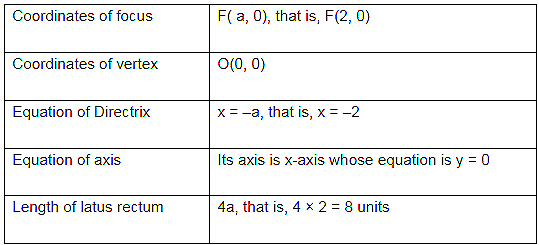Conic Section | Mathematics for Grade 12 PDF Download
| Table of contents |

|
| What is Conic Section? |

|
| Conic Section Formulas |

|
| Conic Sections Equations |

|
| Solved Questions on Conic Sections |

|
What is Conic Section?
A curve, generated by intersecting a right circular cone with a plane is termed as ‘conic’. It has distinguished properties in Euclidean geometry. The vertex of the cone divides it into two nappes referred to as the upper nappe and the lower nappe.
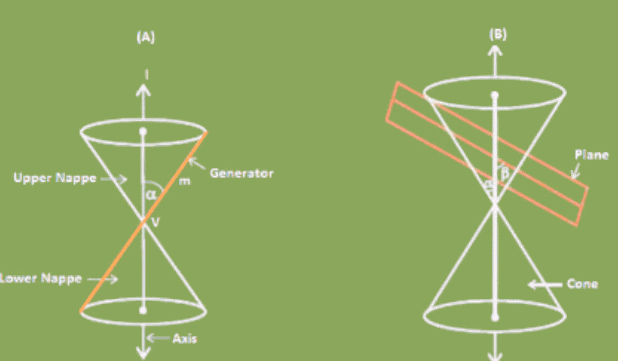
In figure B, the cone is intersected by a plane and the section so obtained is known as a conic section. Depending upon the position of the plane which intersects the cone and the angle of intersection β, different types of conic sections are obtained. Namely;
- Circle
- Ellipse
- Parabola
- Hyperbola
The rear mirrors you see in your car or the huge round silver ones you encounter at a metro station are examples of curves. Curves have huge applications everywhere, be it the study of planetary motion, the design of telescopes, satellites, reflectors etc. Conic consist of curves which are obtained upon the intersection of a plane with a double-napped right circular cone. Let us discuss the formation of different sections of the cone, formulas and their significance.
Conic Section Formulas
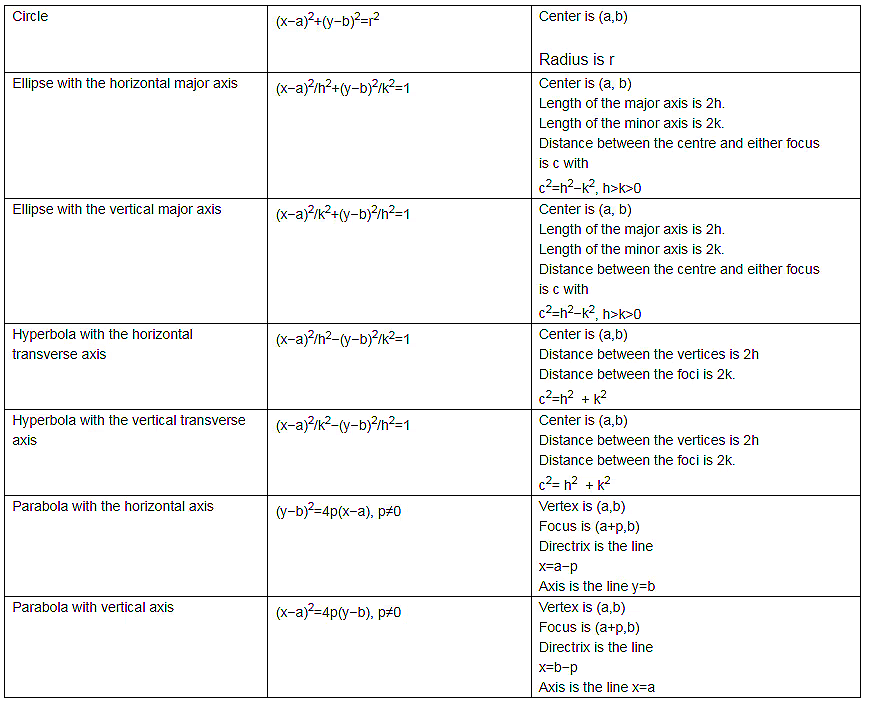
Focus, Eccentricity, and Directrix of Conic
A conic section can also be described as the locus of a point P moving in the plane of a fixed point F known as focus (F) and a fixed line d known as directrix (with the focus not on d) in such a way that the ratio of the distance of point P from focus F to its distance from d is a constant e known as eccentricity. Now,
- If eccentricity, e = 0, the conic is a circle
- If 0<e<1, the conic is an ellipse
- If e=1, the conic is a parabola
- And if e>1, it is a hyperbola
So, eccentricity is a measure of the deviation of the ellipse from being circular. Suppose, the angle formed between the surface of the cone and its axis is β and the angle formed between the cutting plane and the axis is α, the eccentricity is;
Parameters of a Conic
Apart from focus, eccentricity and directrix, there are few more parameters defined under conic sections.
- Principal Axis: Line joining the two focal points or foci of ellipse or hyperbola. Its midpoint is the centre of the curve.
- Linear Eccentricity: Distance between the focus and centre of a section.
- Latus Rectum: A chord of section parallel to directrix, which passes through a focus.
- Focal Parameter: Distance from focus to the corresponding directrix.
- Major axis: Chord joining the two vertices. It is the longest chord of an ellipse.
- Minor axis: Shortest chord of an ellipse.
Sections of the Cone
Consider a fixed vertical line ‘l’ and another line ‘m’ inclined at an angle ‘α’ intersecting ‘l’ at point V as shown below: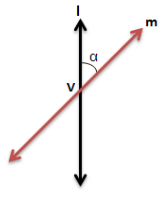
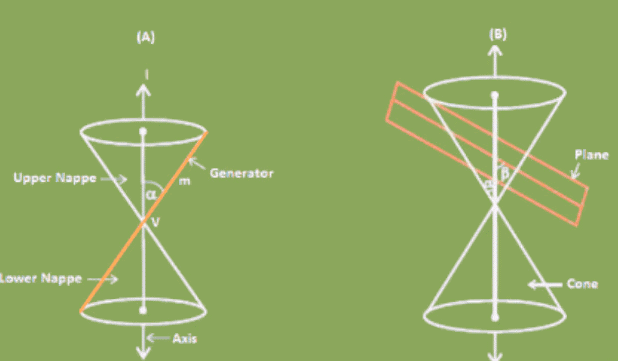
The initials as mentioned in the above figure A carry the following meanings:
- V is the vertex of the cone
- l is the axis of the cone
- m, the rotating line the is a generator of the cone
Let us briefly discuss the different conic sections formed when the plane cuts the nappes (excluding the vertex).
Conic Section Circle
If β=90o, the conic section formed is a circle as shown below.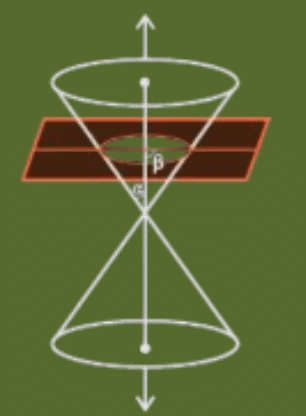
Conic Section Ellipse
If α<β<90o, the conic section so formed is an ellipse as shown in the figure below.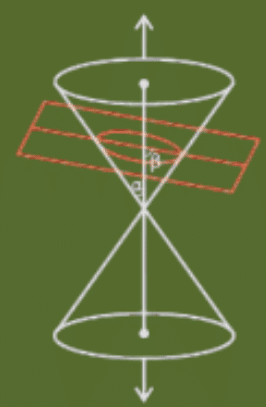
Conic Section Parabola
If α=β, the conic section formed is a parabola (represented by the orange curve) as shown below.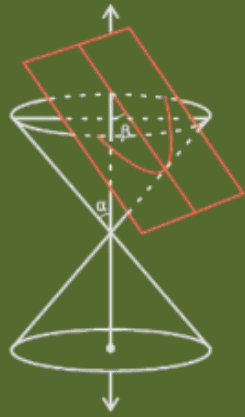
Conic Section Hyperbola
If 0≤β<α, then the plane intersects both nappes and the conic section so formed is known as a hyperbola (represented by the orange curves).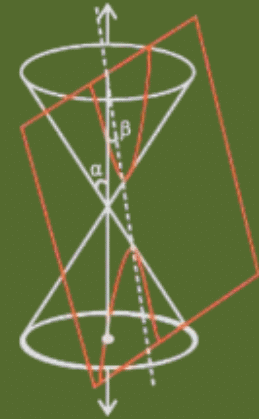
Conic Section Standard Forms
After the introduction of Cartesian coordinates, the focus-directrix property can be utilised to write the equations provided by the points of the conic section. When the coordinates are changed along with the rotation and translation of axes, we can put these equations into standard forms. For ellipses and hyperbolas, the standard form has the x-axis as the principal axis and the origin (0,0) as the centre. The vertices are (±a, 0) and the foci (±c, 0). Define b by the equations c2= a2 − b2 for an ellipse and c2 = a2 + b2 for a hyperbola.
For a circle, c = 0 so a2 = b2. For the parabola, the standard form has the focus on the x-axis at the point (a, 0) and the directrix is the line with equation x = −a. In standard form, the parabola will always pass through the origin.
- Circle: x2+y2=a2
- Ellipse: x2/a2 + y2/b2 = 1
- Hyperbola: x2/a2 – y2/b2 = 1
- Parabola: y2=4ax when a>0
- If the plane intersects exactly at the vertex of the cone, the following cases may arise:
- If α< β≤90°, then the plane intersects the vertex exactly at a point.
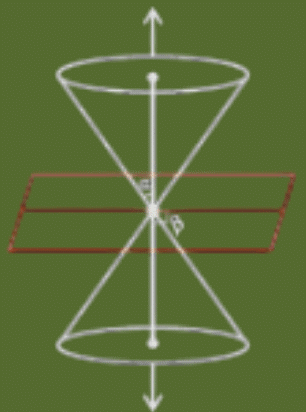
- If α=β, the plane upon an intersection with a cone forms a straight line containing a generator of the cone. This condition is a degenerated form of a parabola.
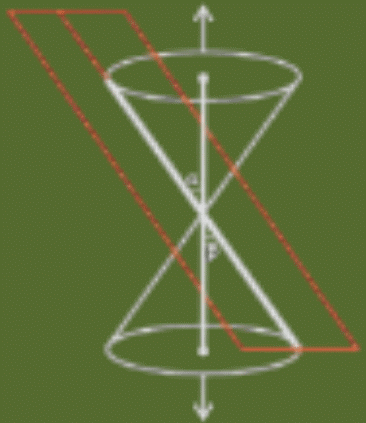
- If 0≤β<α, the section formed is a pair of intersecting straight lines. This condition is a degenerated form of a hyperbola.
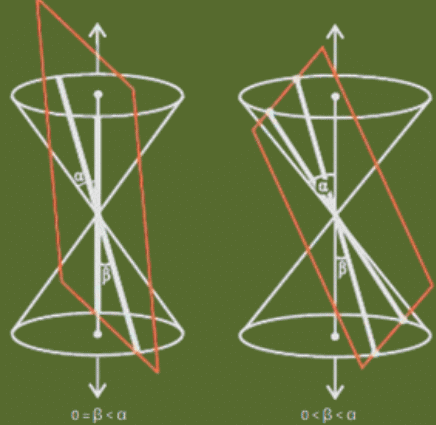
- If α=β, the plane upon an intersection with a cone forms a straight line containing a generator of the cone. This condition is a degenerated form of a parabola.
Conic Sections Equations
Conic Section include Circle , Parabola , Ellipse and Hyperbola and their equations are as follows

Solved Questions on Conic Sections
Q1: Find the coordinates of the focus and the vertex, the equations of the directrix and the axis, and the length of the latus rectum of the parabola y2 = 8x.
Sol:
Comparing the given equation of parabola to the standard form y2 = 4ax, we get a = 2. Thus,
Q2: Given an ellipse whose foci are at (±4, 0) and the eccentricity is ⅓. Find the equation of the ellipse.
Sol:
By the coordinates of focus, we get that the ellipse is a horizontal ellipse whose major axis lies on the x-axis.
Let the equation of the ellipse be
x2/a2 + y2/b2 = 1, where a2 > b2
For an ellipse, the eccentricity e = c/a ⇒ a = c/e where (±c, 0) is the focus
∴ a = 4/(⅓ ) = 12.
Now, c2 = (a2 – b2)
⇒ b2 = (a2 – c2) = 122 – 42 = 128
Hence, the equation of the ellipse is
x2/144 + y2/128 = 1.
|
270 videos|267 docs|155 tests
|
FAQs on Conic Section - Mathematics for Grade 12
| 1. What are the different types of conic sections? |  |
| 2. What is the standard equation of a circle and how is it derived? |  |
| 3. How do you distinguish between an ellipse and a hyperbola? |  |
| 4. What are the applications of conic sections in real life? |  |
| 5. Can you provide an example of a problem involving parabolas and its solution? |  |

